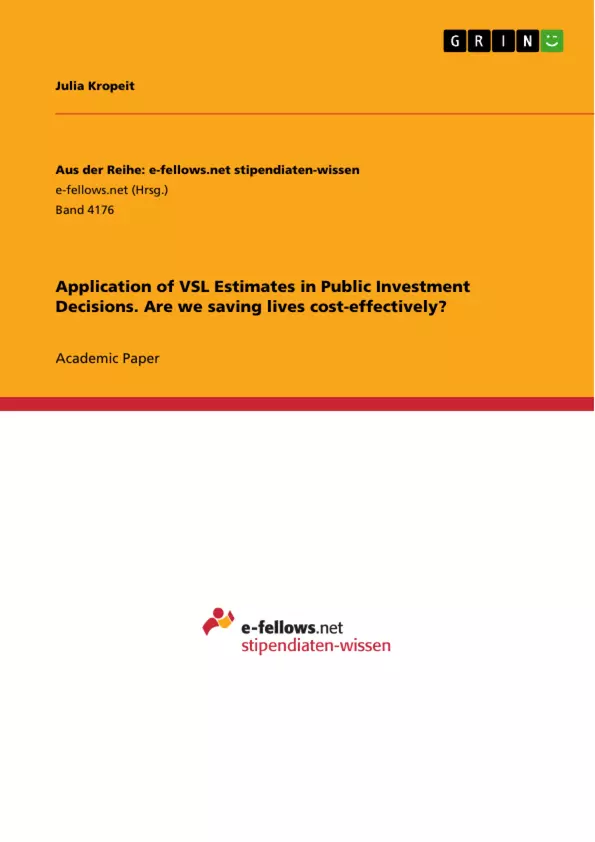This essay will argue that the "values of statistical lives" (VSL) should be seen as a tool that serves to make the implicit trade-offs inherent in any public investment decisions visible and explicit, and thereby allows, given a set of conditions, for a reasonable comparison between competing policy choices.
For policymakers in the U.S., Canada, and the UK, it has long been engraved in their operating instructions to provide and consider an estimation of the "value of lives" affected by new policy measures. Outside of public offices and particularly in continental Europe, attributing monetary values to human lives and trading them off with the necessary costs to save them is an idea likely to awakes moral inhibitions.
Can we put a price-tag on human life? Can the value of an individual be expressed in monetary terms? And, should we even attempt to do so? Many will fiercely reject these questions, based on the firm belief that human life is worth more than money can buy. But, surprisingly to some, it is a rejection that American, Canadian, and British policymakers might be opposed to in just the same way, yet without refuting the justification of the estimates of "values of statistical lives" (VSL).
Governments, inevitably, make life-or-death decisions. Their policies and regulations change the fatality risk exposure of their citizens, ranging from the prescription of safety standards in automobiles to restrictions on hazardous waste disposal. Thereby, policy decisions for or against certain regulations either save or sacrifice ‘statistical lives’ – the lives of previously unidentified people.
Inhaltsverzeichnis (Table of Contents)
- Introduction
- Two opposing philosophical standpoints
- Arguments against monetary valuation of human life
- Arguments for the need of monetary valuation of human life
- Approaches to construct a monetary measure of human life
- Future Earnings
- Revealed Preferences Methods
- Hedonic wage methodology
- Willingness-to-pay estimates
- Discussion
- Application of VSL measures in public policy
- Application of VSL in U.S., Canada, UK
- The role of cost-effectiveness in public interventions - a critique
- Cost-effectiveness of U.S. Government regulations (1970-1990)
- Implicit VSL estimates in public interventions in The Netherlands
- The fallacies of calls for cost-effectiveness cut-offs
- Limitations of VSL-based assessment: cost-effectiveness of H1N1 interventions
- Summary & Conclusion
Zielsetzung und Themenschwerpunkte (Objectives and Key Themes)
This essay aims to provide a qualified argument for the application of VSL (Value of Statistical Life) estimates in public investment decisions. It critically examines the ethical and methodological considerations surrounding the monetary valuation of human life and explores its implications for public policy.
- The ethical debate surrounding the monetary valuation of human life
- Different approaches to estimating VSL, including future earnings and revealed preference methods
- The application of VSL estimates in public policy decision-making
- The role of cost-effectiveness analysis in public interventions and its limitations
- The political and societal implications of VSL estimates
Zusammenfassung der Kapitel (Chapter Summaries)
The introduction of the essay outlines the ongoing debate regarding the monetary valuation of human life, highlighting contrasting viewpoints between those who oppose the concept and those who advocate for its use in public policy decisions.
The second chapter delves into the ethical considerations surrounding the monetary valuation of human life. It presents arguments against attributing a monetary value to human life based on moral and philosophical grounds, emphasizing the inherent value of human life that transcends economic considerations. Additionally, it examines arguments in favor of utilizing VSL estimates, arguing that they are necessary for making informed decisions regarding public investment allocation in areas where limited financial resources are available.
The third chapter explores various approaches to constructing a monetary measure of human life. It discusses the "future earnings" method, which considers an individual's expected future earnings as a proxy for their contribution to society. It also examines revealed preference methods, such as the hedonic wage methodology and willingness-to-pay estimates, which aim to determine individuals' implicit valuations of life through observed behaviors and preferences. The advantages and limitations of these methods are discussed.
The fourth chapter analyzes the application of VSL estimates in public policy. It presents examples of how VSL estimates have been employed in cost-effectiveness analyses of government regulations and investments in the U.S. and the Netherlands. The chapter explores the political implications of using VSL estimates and critically examines claims brought forward by scholars regarding the limitations and fallacies of cost-effectiveness cut-offs in public policy.
Schlüsselwörter (Keywords)
This essay focuses on the Value of Statistical Life (VSL), its ethical implications, and its application in public investment decisions. It explores key themes such as monetary valuation of human life, cost-effectiveness analysis, revealed preference methods, public policy, and the ethical considerations associated with trading off financial resources with the preservation of lives. It draws upon examples from the U.S., Canada, UK, and the Netherlands to illustrate the application of VSL in real-world contexts.
- Quote paper
- Julia Kropeit (Author), 2012, Application of VSL Estimates in Public Investment Decisions. Are we saving lives cost-effectively?, Munich, GRIN Verlag, https://www.grin.com/document/1275902



